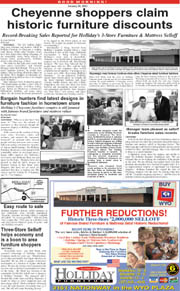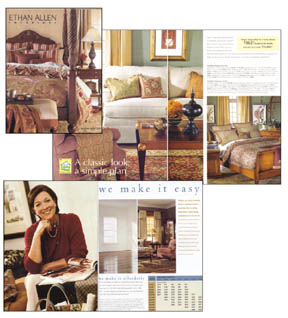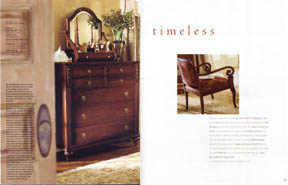Television, radio & print media strategies - plus lessons from Ethan Allen.

The Value Of The Message: Never underestimate the power of the message. Copywriters who can create compelling messages are worth their weight in gold. Give them training in the power of selling copy. The two objects shown left are printed on the same kind of paper with the same kind of ink. Yet, one is worth 100 times more than the other! Why? The message! Don't buy $1,000 worth of newspaper space and make a $50 effort to fill it. Multiply the value of your advertising by giving the word content careful consideration.
D o you know the difference between intrusive advertising, nonintrusive advertising, and permission advertising? If you don’t you are probably wasting a large percentage of your advertising budget.
Each of these three types of advertising should have an important place in your mix. When allocating ad dollars to intrusive, nonintrusive and permission advertising, remember that each type, has its benefits and drawbacks. In this modern world, intrusive advertising is far less likely to generate response than either good nonintrusive advertising or permission advertising. The problem is, really good nonintrusive advertising is much more difficult to create. Also, intrusive advertising media such as television is far more glitzy and ego-building for retailers. Television offers fat built-in commissions for independent agencies, and so-called house agencies. This may be fine for some, but my experience has shown that the retailer who wants the most advertising bang for the buck, should pay heed to the print media renaissance and the limited (but still important) internet potential for promoting your store. (Not furniture items, your store brand.)
YOU ARE SELLING SOMETHING UNIQUE
This is the most important lesson you can learn: Good furniture and mattress advertising is very different than ads that promote lower ticket items such as tennis shoes or jeans. Don’t use successful ad campaigns for these products as models for promoting your store. Furniture and mattress sets are higher ticket items whose purchase is routinely and easily deferred. Your customers commonly wait as long as four or five years after they begin to see wear on these kinds of items before they shop in earnest for a replacement. They are rarely impulse items. Most people have no idea what a "hot price" on a mattress or a sofa might be. In this sense, home furnishings are like tires, carpet, cars, appliances and bigger electronics. This means that there are always large numbers of home furnishings prospects in the market at any given time, waiting to make a trip to a furniture store. The secret of a high-impact ad campaign is the ability to pull from this large pool of lukewarm prospects with a strong appeal to buy now. Then, after the high impact event, the store must immediately get back to day-to-day business with a lighter, but carefully orchestrated and branded, touch.
Make no mistake. Although this article is generally focused toward day-to-day selling, for big ticket items, wisely planned, strong promotional events will always be important to increase market share and dramatically affect sales and profits.
INTRUSIVE ADVERTISING
Air media, especially television and radio, are intrusive media. Clutter has forced advertisers to attempt to stand out, and in many markets furniture retailers have created ads that are noisy, flashy and obnoxious. Research indicates that, unlike newspapers, the public would prefer television and radio without commercials. More enlightened furniture advertisers are realizing that their appeals must reach the ears and eyes of women. An intrusion of beautiful furniture displays and tasteful appeals are less annoying to women than loud and busy, egoistic commercials.
 |
The Ultimate Who? What? When? Where? How? Why? Ad: This seemingly unimposing ad gives competitors fits. It mixes persuasive editorial-like copy and newspaper format with a good small-space ad. The ad achieves branding and sells merchandise as no other. Each element of the formula above is carefully weighed with a checklist. Such an ad takes knowledge and time to execute. It makes advertising space worth many times what an ordinary ad can achieve. Is it worth the work? Yes, this ad remains the most productive event ad, year after year. Not only that, but properly done, this type of ad achieves better cost-effective branding for a smaller independent than any other form of advertising. |
THE TV-EGO TRAP
In its days of explosive growth, Levitz Furniture found that Southern California was a "tough nut to crack." It’s very hard sell newspaper ads and pitchman television spots were not working. "The customers here are different," said the sales managers and ad people. When they were persuaded to invest in concept-type commercials and coordinated print appeals, it turned on their business like magic. Levitz began to show TV commercials with high quality, moving shots of their interior displays and warehouses. They began to run ads featuring themes of selection of the latest styles, lower prices and immediate availability. Since then, this general idea of TV-Print synergy continues to develop and improve. It has worked over and over again, resulting in day-to-day success for furniture retailers. But, Levitz gradually abandoned the proven formula. Very seldom does a furniture store stick to a coordinated concept idea augmented with strategically placed, powerful events.
Why? Impatience usually steps in, altering the wisdom of this proven formula. One once well-known furniture retailer sought to emulate the Levitz success in the seventies. Outstanding print was developed, and a very high-profile television effort. The television was, however, the old pitch-man appeal. An instore agency, owned by the CEO’s wife was created. Soon the CEO of the company was making many times more money from his salary as a television talent and from agency commissions than he was from heading the furniture chain. Media decisions were no longer objective. Then the concept method of television advertising was attempted, resulting in the largest month in the company’s history, only to be abandoned in favor of the pitchman, item price approach. TV budgets increased, and the company was in bankruptcy soon after going to an all-television strategy.
If you have a large number of locations, television can be cost-effective. Then you may be able to afford to expose customers to enough concept commercials to get your message across. Few independents are able to do this. On the other hand, radio is affordable for most retailers. It is most effective when used in conjunction with events. Again, price-item spots are not effective on radio. Either way, make sure that if you use television or radio, they send the same message as your other advertising efforts.
Being a spokesperson for your company can be very effective, but don’t hog the camera. Anyone can be a stand-up pitchman. Your radio and television ads should always point out a service or feature provided by your store, that no other retailer can copy. This is effective branding.
 |
Ethan Allen Uses A Magazine Cover Approach To Their Circulars: This has the advantage of aesthetic appeal, especially to the higher-end customer who gets the brochure by mail. Visual impact is very powerful. For a more middle end appeal and newspaper insertion, some adjustments may be advisable to get the customer inside. (MIDDLE) A good benefit headline, coordinated merchandising, and powerful appeal using terms to off-set the big ticket. (BOTTOM) An entire spread is devoted to terms. A lovely, non-threatening female "design consultant" looks out, and a simple box explains the benefits of the Ethan Allen plan. The promise of the headlines to "make it easy" and "make it affordable" is fulfilled. |
NONINTRUSIVE ADVERTISING
The most effective way to send messages to consumers about high-ticket items that they need, but are not actively shopping for, is through print media. Newspaper can be used productively if you take the time and make the effort. But you can’t buy $1,000 worth of newspaper space and put $50 worth of effort into creating your message, and expect it to work. All the newspaper can do is deliver the white space. The problem is, very few retail copywriters and graphic artists are trained in the basics of making print advertising work.
Sure, not everyone reads the newspaper, but don’t believe the myth that people don’t read anymore. Walk into Walden, or Barnes & Noble, or Borders on any given Sunday. People are hungry to read about topics and products in which they have an interest. Don’t believe that the younger generation doesn’t read. They are the best educated generation in history. Just look at a computer catalogue and see all the copy that is used to sell merchandise. And that brings us to an important point for any furniture person. Who wants to read about furniture? Who wants to read about mattress sets? The answer is critical to your success.
The answer, we all know, is that women like to read interesting messages about home furnishings. As far as mattresses go, the readership is more balanced, but still favors women. People want information about sleep and about back pain caused by too little sleep. They want to know how sleep can energize them. How many mattress ads do you see that take advantage of these facts? Specialty stores, such as mattress stores, succeed because regular furniture stores generally fail to do a good job promoting a given specific product category. Dinette stores, leather furniture stores, and other stores that sell a narrowly defined home furnishings category create a lucrative niche because full line furniture stores neglect to romance and promote these products properly.
By far the most effective furniture advertising vehicle is the full color preprint, delivered by mail and also inserted into the newspaper. Many are poorly designed and contain weak copy appeals, yet they are working fairly well for stores because few competitors are masters at using print. Perhaps the most successful furniture chain in America uses the preprint with great success. If you want an education in how to appeal to women’s hunger for information about home furnishings, examine Ethan Allen’s preprint efforts. The company boasts nearly 100 percent brand awareness. Ethan Allen has grown wisely and successfully, in part through these consistent and persuasive advertising pieces.
ETHAN ALLEN’S CURRENT PREPRINT
The current "winter sale" effort for 2002 by Ethan Allen contains 48 pages of professionally planned full color advertising. There are weaknesses, of course, but anyone can nitpick a creative work. I will proceed to do this a bit before I emphasize the mastery of this piece. From a merchandising point of view, there is no space devoted to mattresses. When I called, a pleasant female voice answered on the first ring: "Good morning, Ethan Allen Interiors." I asked if they carried mattresses. "Yes, let me connect you with a designer-consultant." Very quickly another female voice identified herself. I repeated the question, and asked if any mattresses were included in the Winter Sale. "Yes, they are on sale. I wish they had been included in our sales piece. Many people call our fine mattress selection our best kept secret . . ." The lady then went on to ask questions and roll out some impressive facts about Ethan Allen mattress sets. She also gave me an attractive price point on a California King set. Obviously, Ethan Allen needs to bring this important category into the loop in their preprint advertising.
From a graphics perspective, the piece was virtually flawless. The only critique I can muster is that the overprinted message on the inside front cover is impossible to read. Some of the body copy is needlessly small. Also, the short message from the CEO (a nice touch) has no face to go with it. People like to look at a face. Another weakness is that the piece is written essentially to existing customers, and tells me very little about the tradition and history of this great company. Who cares? This is an essential element of our formula for print: Who? What? When? Where? How? And Why? No one cares to look at a factory, but a human touch about the loving care that goes into this furniture would help the piece. It would impress a new prospect to know that Ethan Allen is unique, and over the course of 65 years has blossomed into the largest international furniture manufacturer and retailer by maintaining its commitment to quality, style, service and value. Currently, approximately 90 percent of Ethan Allen products are made in the United States. All of this information helps a new prospective customer make the decision to try Ethan Allen.
Now, consider the strengths of the appeal Ethan Allen makes in this piece. Here is a full color magazine, a feast for the woman who is interested in new home furnishings. Page after page features large beautiful pictures of furniture in lush room settings. Copy is carefully written by experts, romancing the theme of each display with a short paragraph that carries the lifestyle theme throughout the piece. The copy is written to be of interest to the consumer, and is not just "puffy stuff" about Ethan Allen. Monthly payments are featured on virtually every spread. When a woman sees her heart’s desire, she does not have to tell her husband it will cost them $4,076 for a new French bedroom, but only $83 dollars a month for 60 months.
Credit terms fall into the "How" category of informing customers. Looking at a breathtaking ensemble of furniture, the question of "How" must come into the prospect’s mind. "How can I afford this?" Ethan Allen makes it easy to answer this question.
There is also a two-page spread, devoted exclusively to credit. There are no glaring headlines offering one, two or three years of free credit. But the credit terms are reasonable and they are clear. A chart of terms is worth examining. It goes from a $2,000 purchase to a $50,000 purchase. A lovely "designer consultant" looks out from the two page spread, and the copy is compelling: "Live in the lifestyle you desire—our revolutionary Simple Finance Plan can make it happen today. Enjoy the furniture you’ve always wanted as you pay for it. SFP offers fixed monthly payments and a 7.99% APR. No more creating your dream home one chair at a time. Ethan Allen. We’re more affordable than ever before."
If the consumer has any further doubt about "How?" they can look on the back cover to find that they received their copy through American Express, and because of this can shop the sale a day ahead of time. They also learn that they can use Visa or MasterCard. Finally, this piece has accessories woven through, and includes spreads on "one stop shopping." These feature complete stories on window treatments, walls, bed coverings, lighting, rugs, etc. This piece is full of valuable information; few women would just toss it. Of course, the average retailer can’t compete with a 48-page full color tab. But he or she can put together an excellent 4, 6 or 8-pager, and can put as much thought and effort into the product as the pros at Ethan Allen. Get such a selling piece in the hands of your customers, and coordinate it with your TV and radio. Do this on a regular basis and watch your sales zoom.
Study and learn the secrets that make print work. In our next issue, we will show you what several million dollars worth of research by advertising greats has revealed about the things that make print advertising the most valuable selling tool in your arsenal. (A simple change in a headline can double response! A grey tone behind copy can cut readership 73%!) We will also cover direct mail, a semi-intrusive, but very powerful medium. And finally, we’ll give you ideas on the latest advertising vehicle, the magic of permission marketing. Meanwhile, get a knowledgeable furniture pro to develop some great print advertising templates for your business. And, don’t miss the next issue of Furniture World.

Of Course, Nobody’s Perfect: Smart Furniture dealers will learn from the great things Ethan Allen does, and also from their mistakes. Copy on the inside cover (the first thing most customers will see) is overprinted on a photo and is almost impossible to read. Right, the copy is smaller than necessary, grey and hard to read. Research shows such needless errors can reduce readership up to 75%. The one word headline: "timeless", has nothing to do with the copy block, which is a message from the CEO about Ethan Allen's commitment. This is all OK for old Ethan Allen customers, but it puts up barriers for new customers. In addition, new customers might like to know something about the company. Not a mention in the 48 pages about the 65-year commitment of Ethan Allen to "quality, service, style and value." Nor their fourteen furniture plants, six upholstery plants, two accent plants, and three sawmills (all in the good old USA). By failing to take a little of that white space to say things competitors cannot, Ethan Allen drops the ball. These wonderful things that can help new customers discover Ethan Allen may as well not be true, and competition can be grateful for the omission.
Larry Mullins, President of UltraSales, Inc., has 30+ years experience in the front lines of retail furniture marketing. Larry's mainstream executive experience, his creative work for "promoter-specialists," and study of advertising principles has enabled him to continually develop new High-Impact strategies for independent furniture retailers that are sound, complete, and innovative. Inquiries can be sent to Larry care of FURNITURE WORLD at editor@furninfo.com.